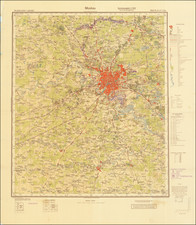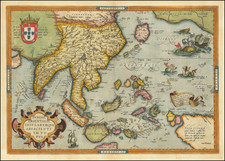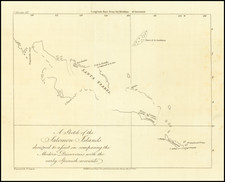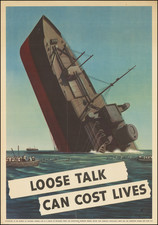"SECRET" Beach Diagrams used for Planning and Executing the American Landings on Iwo Jima.
Two very rare color-printed views of the southern beaches of Iwo Jima, the southwestern section of which served as a potential landing area for the U.S. Marine Corps, and the southeastern of which served as the actual landing area. Both bear the "SECRET" classification.
The Diagrams
These two diagrams present a general view of the two potential landing beaches at the southern end of the island, along with notes about the conditions in each of the roughly 500-yard-wide landing zones. The notes cover "Beach Extent", "Beach Approaches", "Nature of Beach", "Terrain Inland", "Exits", and "Obstacles". There is also a set of notes for the General conditions affecting all beaches.
The southeastern beaches, site of the actual landing, are divided into zones "Green 1", "Red 1", "Red 2", "Yellow 1", "Yellow 2", "Blue 1", "Blue 2". On the first day of the invasion, the 4th Marine Division landed at the Blue and Yellow beaches, while the 5th Marines landed at the Green and Red. The 3rd Marine Division was held in reserve and committed to the central sector on the 22nd of February.
Mount Suribachi, or "Hot Rocks" as it was codenamed, appears at the far left or right of the diagrams.
Accuracy of the Diagrams
The diagrams relied on aerial photographs made on July 4, 1944, more than seven months before the invasion. They show little in the way of manmade impediments to amphibious invasion, belying the extensive Japanese fortifications and the dogged resistance that the Marines would face from the roughly 20,000 defenders. Eschewing Japanese doctrine, which called for him to contest every inch of the landing beaches, Lieutenant General Tadamichi Kuribayashi instead instructed his soldiers to allow the American forces to land en masse, before springing traps to kill as many newly-landed troops as possible.
American planners also misunderstood the nature of the volcanic sand and terrain of the beaches, most of which was thought to be perfectly suitable for disembarking and traversing. In these diagrams, particularly the one for the southwestern beaches, the volcanic sand is described as "firm" and "firm enough for movement of vehicles". In reality, the ash was very difficult to traverse, and equally difficult to dig into, greatly complicating the unloading of equipment and vehicles and the excavation of foxholes and trenches.
These errors were symptomatic of a general lack of accurate pre-invasion intelligence, which ultimately cost hundreds, even thousands of American lives.
Rarity
OCLC records two copies (one at Harvard and the other at East Carolina).
Another set of these diagrams was featured in an episode of the TV show Pawn Stars. Rick Harrison, the host of the show, wrote that he had sold one of the two views for $10,000.
Iwo Jima, whose name translates as "Sulfur Island", was an important midway point between South Pacific bomber bases that were already in the hands of the Allies and the Japanese home islands. 700 miles from Tokyo and 350 from the nearest U.S. airbase, with a central plain suitable for building large runways, American planners viewed it as a valuable target. The battle for the island was among the bloodiest of the Pacific Theater of the Second World War. In total, 6,800 U.S. Marines lost their lives and 26,000 were wounded, while a staggering 18,000 Japanese defenders died.












![[ Tokyo ] Map of the Suburbs of the Eastern Capital. Or Edo.](https://storage.googleapis.com/raremaps/img/small/102002.jpg)

